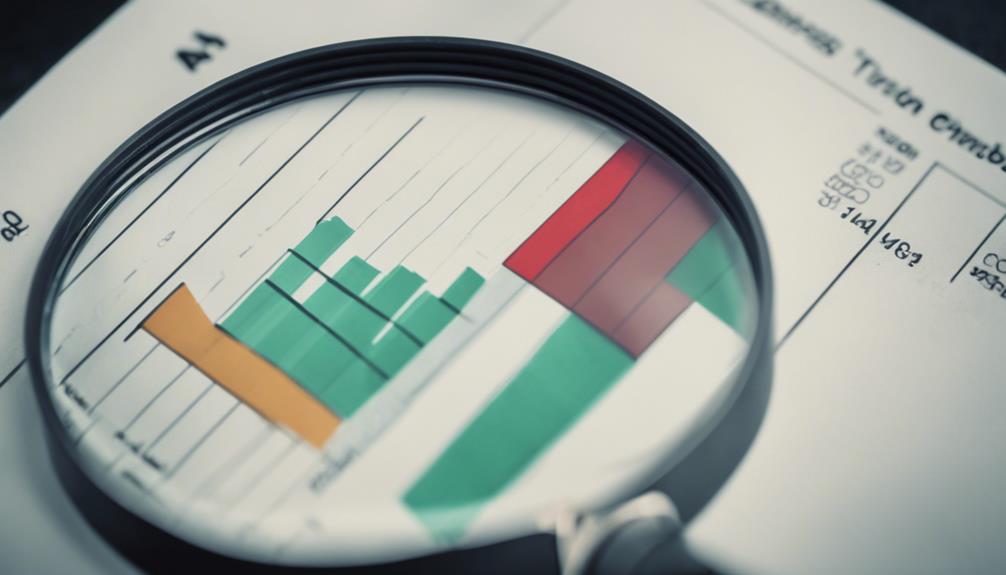To harness the power of your accounts receivable ratio, focus on evaluating your business's efficiency in collecting credit payments. This ratio reflects how well you manage cash flow, credit policies, and decision-making processes. A high ratio signals prompt payments and smart credit policies, while a low one may mean delays and operational hiccups. Optimizing this ratio can improve financial health and operational effectiveness. Understanding the significance, calculating the ratio, and knowing its impact can boost your company's performance. Exploring industry benchmarks, embracing automation, and optimizing payment collection workflows are key steps. Discover the potential of your accounts receivable ratio for enhanced financial management and operational efficiency. Additionally, monitoring and analyzing your accounts receivable ratio can help identify areas for improvement and potential risks. By maximizing take rates through efficient credit collection strategies, businesses can minimize outstanding debts and improve their overall financial stability. Utilizing technology and data analytics can also help streamline the payment collection process and identify opportunities for increasing the accounts receivable ratio.
Key Takeaways
- AR Turnover Ratio evaluates payment efficiency and credit policies.
- High ratio signifies effective collections and streamlined processes.
- Benchmarking against industry averages aids in strategic decision-making.
- Automation enhances accuracy, efficiency, and timely payment reminders.
- Optimal management of AR turnover ratio boosts financial performance.
Significance of AR Turnover Ratio

The significance of the AR Turnover Ratio lies in its ability to provide valuable insights into your business's efficiency in collecting payments on credit sales. This metric serves as a powerful tool for evaluating how effectively your company manages its accounts receivable.
By measuring how many times a year your business collects outstanding credit sales, the AR Turnover Ratio offers essential information on cash flow, credit policy effectiveness, and overall decision-making processes.
A high ratio indicates prompt payment collection, streamlined processes, and efficient credit policies, while a low ratio may suggest delayed collections, operational disruptions, and potential impacts on customer satisfaction.
Understanding and optimizing your AR Turnover Ratio can enhance your business's financial health and operational efficiency.
Calculation Process and Example

How do you calculate the Accounts Receivable Turnover Ratio effectively for your business?
To determine this ratio, first, find your net credit sales. Subtract any returns or allowances from your total sales.
Next, calculate the average accounts receivable by adding the beginning and ending accounts receivable for a specific period and dividing by two.
Finally, divide your net credit sales by the average accounts receivable to get your Accounts Receivable Turnover Ratio.
For example, if your net credit sales are $500,000 and your average accounts receivable is $100,000, your ratio would be 5. This means that, on average, you collect payment from your customers five times throughout the year. This can be a helpful metric for understanding your cash flow and the efficiency of your accounts receivable process. Understanding take rates in business can also help you make informed decisions about how to improve collection efforts and manage outstanding balances.
This means you collect your outstanding accounts receivable five times a year on average.
This ratio can offer insights into your credit policy effectiveness and cash flow management.
Impact of High/Low Ratios

Experiencing a high or low accounts receivable turnover ratio can greatly impact your business operations and financial health. A high ratio suggests vital credit policies, streamlined processes, and prompt payment collection, which can enhance cash flow and customer satisfaction. On the other hand, a low accounts receivable turnover ratio may signal inefficiencies in credit management, collection processes, and customer creditworthiness assessment. This can lead to cash flow constraints and potential bad debt write-offs. It is essential for businesses to actively manage their accounts receivable turnover ratio in order to maximize take rates and ensure a healthy financial position. Regular monitoring and adjustments to credit policies and collection efforts can help improve the ratio and ultimately the overall financial health of the business.
On the other hand, a low ratio indicates delayed collections, potential cash flow issues, and disruptions in operations and customer relations. Comparing your ratio to industry averages can provide valuable insights for benchmarking and strategic decision-making.
Understanding the implications of these ratios is essential for managing outstanding accounts receivable effectively and optimizing your business's financial performance. Keep a close eye on your accounts receivable turnover ratio to maintain a healthy balance between credit management and operational efficiency. Identifying trends and patterns in your accounts receivable turnover ratio can also help you understand the power of take rates in your business. By analyzing how quickly your receivables are turned into cash, you can make informed decisions about credit policies and collections strategies to improve your overall financial health. Ultimately, understanding the power of take rates can lead to a more streamlined and efficient accounts receivable process, benefiting your business in the long run. To further improve your business’s financial performance, consider strategies for increasing take rates. By incentivizing early payment or offering discounts for prompt payment, you can speed up the accounts receivable turnover and increase cash flow. Additionally, implementing automated invoicing and payment processing systems can help reduce the time it takes to collect on outstanding receivables, ultimately increasing take rates and improving overall financial health. By leveraging technology and data analytics, you can identify areas where you can streamline operations and improve customer satisfaction, ultimately leading to an increase in take rates. Offering flexible payment options and personalized invoicing can also help to increase the speed at which receivables are converted into cash. By continually monitoring and analyzing your accounts receivable turnover ratio, you can proactively identify opportunities to increase take rates and optimize your business’s financial performance.
Industry Benchmarking and Averages

Benchmarking your accounts receivable turnover against industry averages provides valuable insights for evaluating your financial performance. When evaluating your AR turnover ratio against industry standards, you can gain a better understanding of where your company stands and identify areas for improvement.
Here are some key points to take into account:
- Identify top-ranking industries for AR turnover ratio
- Understand your company's position relative to industry standards
- Leverage benchmarking to assess your financial efficiency
- Note the limitations of the ratio, such as using total sales instead of net sales.
Automation Benefits and Efficiency

To enhance your accounts receivable turnover efficiency, consider leveraging the benefits of automation for streamlined processes and improved accuracy. Automation offers advantages such as enhanced accuracy, reduced errors, and automated reminders for due dates. By optimizing payment collections workflows and accelerating invoicing and payment processing, automation can greatly improve efficiency.
Automated systems provide timely reminders, streamline processes, and integrate with accounting software for enhanced productivity. These features not only boost efficiency but also contribute to improved customer satisfaction and better cash flow management. Embracing automation in your accounts receivable processes can lead to smoother operations, increased accuracy, and ultimately, a more efficient financial management system.
Frequently Asked Questions
How Does the AR Turnover Ratio Affect a Company's Cash Flow Management?
The AR turnover ratio directly impacts your company's cash flow management. A high ratio indicates efficient collection of credit sales, boosting cash flow.
Conversely, a low ratio suggests delays in receiving payments, affecting available funds. By analyzing this ratio, you gain insights into your cash flow health, allowing you to make informed decisions to improve collections, streamline processes, and enhance financial stability.
Understanding and acting on this metric can greatly influence your company's financial well-being.
What Strategies Can Help Improve a Low AR Turnover Ratio?
To improve a low AR turnover ratio, focus on efficient payment collections. Streamline processes, set clear credit policies, and monitor outstanding accounts closely.
Implement automated reminders for due dates and optimize workflows for faster invoicing and payment processing. By enhancing accuracy and efficiency through automation, you can boost cash flow, customer satisfaction, and overall management of accounts receivable.
Keep a sharp eye on industry benchmarks to gauge progress and make necessary adjustments.
How Can Industry Benchmarking Help in Setting Credit Policies?
Industry benchmarking aids in setting credit policies by offering insights into best practices and performance standards. By comparing your AR turnover ratio to industry averages, you can gauge the effectiveness of your current policies.
High ratios may suggest efficient practices, while low ratios could signal room for improvement. Benchmarking helps in identifying areas for adjustment, ensuring your credit policies align with industry norms for peak efficiency and customer relations.
What Are the Potential Risks of Relying Solely on AR Turnover Ratio?
Relying solely on AR turnover ratio poses risks in overlooking other financial aspects. A narrow focus may obscure broader issues like credit quality or collection efficiency. Diversifying analysis to include inclusive metrics is advisable for a thorough financial assessment.
Consider incorporating metrics like Days Sales Outstanding or Bad Debt Expense to gain a panoramic view of your receivables management. Balancing multiple indicators can provide a more thorough understanding of your financial health.
Can Automation of AR Processes Lead to Increased Customer Satisfaction?
Automation of AR processes can boost customer satisfaction by improving accuracy and efficiency. Automated systems can provide timely reminders, streamline processes, and integrate with accounting software. This leads to faster invoicing, quicker payment processing, and reduced errors.
Ultimately, these enhancements contribute to better customer experiences through smoother transactions and more consistent interactions, fostering positive relationships and trust.
Conclusion
To sum up, harnessing the power of the Accounts Receivable Turnover Ratio is crucial for optimizing your cash flow and credit management. Are you prepared to delve deeper into your financial data and make informed decisions to propel your business forward? Understanding the power of take rates can also help you better assess the overall health of your sales and collection processes. By analyzing the relationship between your Accounts Receivable Turnover Ratio and take rates, you can identify any potential areas for improvement and implement strategies to enhance your cash flow and credit management. With this knowledge, you can confidently navigate the complexities of your finances and drive your business towards greater success. Optimizing take rates is essential for maximizing the revenue generated from each transaction and improving the efficiency of your payment processing. By closely monitoring and analyzing your take rates, you can identify patterns and trends that can help you make strategic adjustments to drive higher profitability. This proactive approach to managing your payment services can have a significant impact on your overall cash flow and ultimately contribute to the long-term success of your business.
Understanding and utilizing this pivotal metric won't only boost your efficiency but also offer valuable insights for strategic planning. So, why hesitate? Begin analyzing your AR turnover ratio today and unleash the potential for financial success.










